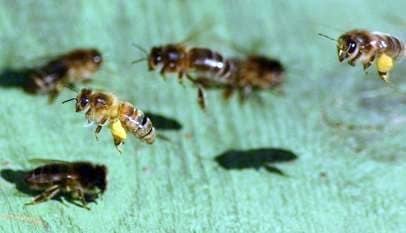
During the wintering in the courtyard in the southern regions with a short and mild winter beehives with bees are left in their places without additional external warming. In areas with snowy winters, single-stem hives are covered with snow, and double-walled beehives can not be covered with snow. If the bees hibernate in more severe conditions, the hives are additionally wrapped with tar paper, roofing paper or thick paper so that between them and the hive there is a space of 12-15 cm, which is filled with dry foliage, small shavings, straw, etc. The bees are well wintered in special covers, which are manufactured for one, two or four beehives. In this case, the hives on the sides, on top and bottom are covered with shields made of slabs, boards and other cheap local materials. The space between the casing and the hive is filled with insulating material 15-20 cm thick.
Families who leave to spend the winter in the yard should be with uterus, grown in good conditions, strong, hardy and resistant to diseases. Such families, in comparison with wintering in the winter hut, need to provide forages of fodder – at least 2.5 kg per lane and 2-3 frames with perga. In the nests, leave 1-2 frames more than bees.
To prevent humidification of the hive, the nest is placed in the center of the hive, and the diaphragm and insulating material are placed on the sides. On top of the nest is also laid insulation, which does not interfere with the exchange of air. Cut the upper tray in hives – sunbeds up to 5-7 cm, in multi-hull beats do not cut, and the bottom tray is completely closed. The flaps are blocked from the mice by the barriers. Well winter bees hibernate on 18 mm wide streets.
When the winter warms to 8-12 њ C, the beehives are released from the top of the hives from the snow, if they are pelted, clean the tapes, and also determine the need of the families in the stern. To do this, remove the roof of the hive and inspect the nest from the top. If the club is calm and a lot of honey, such families do not need help. When the eggs are laid by the uterus on the honeycombs of the lower hulls in these families, the families from the upper hull take out the full border with honey from the upper hull, and the last frames from the middle are pushed to the walls of the hive, so that in the center a space is formed where the honeycombs with the brood are carefully moved from the lower body place the frame with bees, the extreme place honey frames from the upper body. The housing with the brood is placed top. When this is not done, the bees will not leave the brood and, having consumed the feed, will perish. In the absence of food in the nests, bees are fed, as described above.
Работа с двухкорпусными ульями. Кормовая база в пчеловодстве.
Hibernation of bees